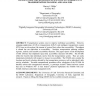Free Online Productivity Tools
i2Speak
i2Symbol
i2OCR
iTex2Img
iWeb2Print
iWeb2Shot
i2Type
iPdf2Split
iPdf2Merge
i2Bopomofo
i2Arabic
i2Style
i2Image
i2PDF
iLatex2Rtf
Sci2ools
GEOINFORMATICA
2000
2000
GIS Software for Measuring Space-Time Accessibility in Transportation Planning and Analysis
: Transportation systems exist to improve individual accessibility. However, emerging applications of GIS in transportation (GIS-T) and intelligent transportation system (ITS) focus on throughput (the amount of system flow) rather than accessibility. Throughput is related but not equivalent to accessibility. Sensitive transportation planning requires rigorous, realistic and tractable accessibility measures. This paper reports on the development of GIS software that implement space-time accessibility measures (STAMs). The STAMs reflect the benefits that individuals receive from the transportation system. They are easily interpreted, particularly with respect to changes in accessibility. The STAMs also consider the locations and travel velocities dictated by the transportation system as well as individuals'daily activity schedules. Tractable computational procedures allow calculation of the STAMs for detailed, urban-scale transportation networks. A prototype ArcInfo
| Added | 18 Dec 2010 |
| Updated | 18 Dec 2010 |
| Type | Journal |
| Year | 2000 |
| Where | GEOINFORMATICA |
| Authors | Harvey J. Miller, Yi-Hwa Wu |
Comments (0)

